We have a world population expected to grow by 1.2 billion people within 15 years1, coupled with a growing demand for meat, eggs and dairy, which soak up over 70% of fresh water for crops2, plus electricity demand that’s growing even faster than population growth3 … what are we supposed to do about all of that? Well, we can combine two of my favorite things: technology and food. Both of which I’ve been accused of having too much of. But, could combining solar panels plus farming be a viable solution to all of those problems? Let’s take a closer look at electrifying our crops … not literally electrifying crops … never mind … let’s take a closer look at adding solar to our farm land as well as some of the side benefits … and challenges … it creates.
The problem with solar panels is that they need a lot of space to generate serious amounts of electricity. Agrivoltaics4 or APV for short, combines agriculture with electricity generation by farming under a canopy of solar panels … and there’s some really interesting recent examples that make a compelling case for it, but before getting into that it’s a good idea to understand the challenges around solar parks in general and some of the solutions that have been developed.
Solar parks in rural areas have been around for almost two decades5. The major problem with this type of solar installation is that the ground beneath the panels can’t be used, mainly due to the small spaces between the rows of panels which aren’t large enough for modern farming equipment to pass through.
It is possible to convert a typical solar park into dual land use when it’s designated as a living area for grazing by small livestock like chicken, geese, and sheep, as well as for beekeeping.

These animals are beneficial to solar farms because they reduce the cost of maintaining vegetation growth and don’t introduce any risk to the panels themselves. The same can’t be said of something a bit larger like pigs, goats, horses, or cattle6 … it’s a known fact that cattle hate solar panels.
When more space is allowed in between the solar panel rows, crops can be grown there. However, the space beneath the panels still isn’t usable and needs to be maintained. This is considered alternating land use instead of dual land use because there are areas of the land that are one or the other … not both solar and crops at the same time. The land between the rows will be shaded during some hours of the day, meaning you’re altering the characteristics of the land and the types of crops that can be grown.
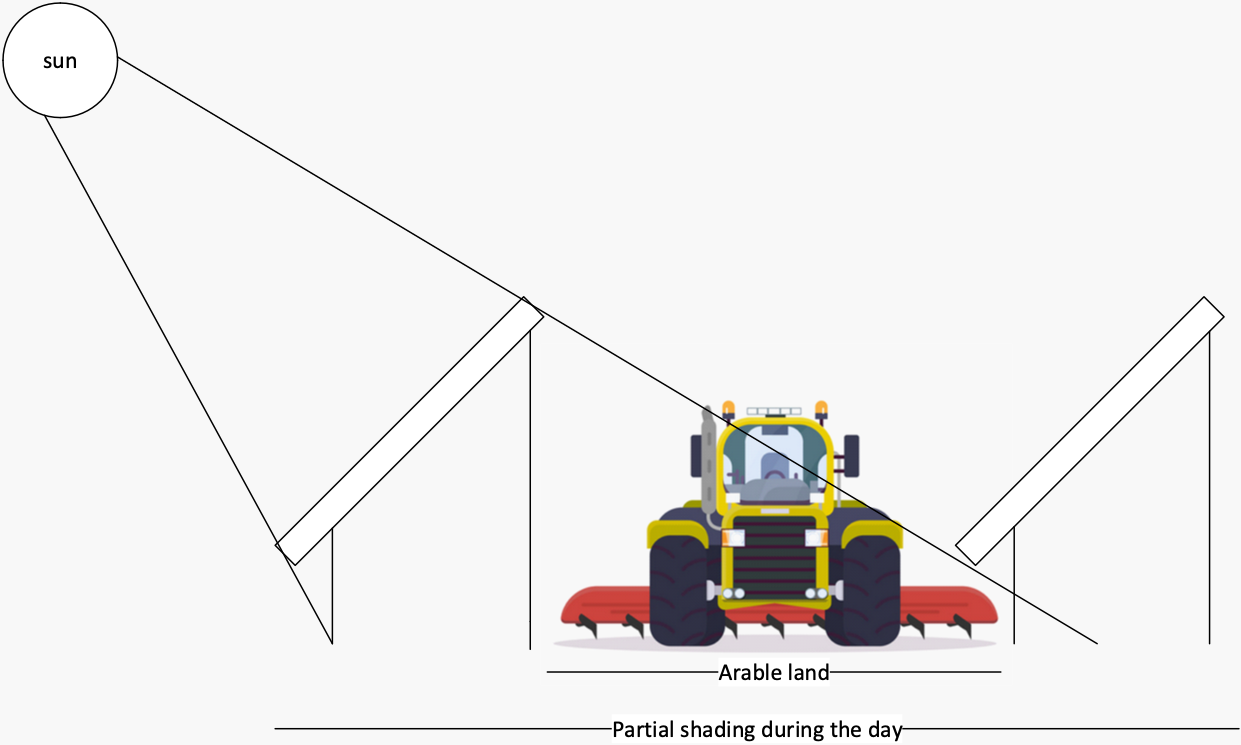
So what if we started to go vertical with our solar panels? That’s where we start to get some interesting alternatives to standard ground mounted solar park style installations.
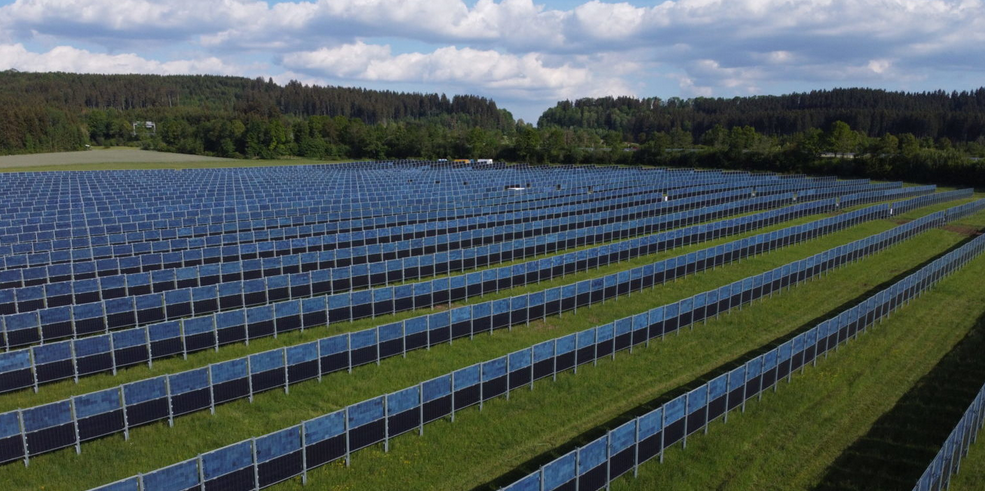
Using vertically mounted bifacial modules7 allows for more arable land. And if you don’t know what bifacial solar panels are, they can collect solar energy from both sides of the panel8. This type of installation would work particularly well in areas that suffer from wind erosion, since the structures reduce wind speeds which can help protect the land and crops grown there. The bifacial panels also can generate more power per square meter than traditional single faced panels and don’t require any moving parts9.
Then there’s also the option of mounting panels on stilts, which allows farming machinery to pass underneath.
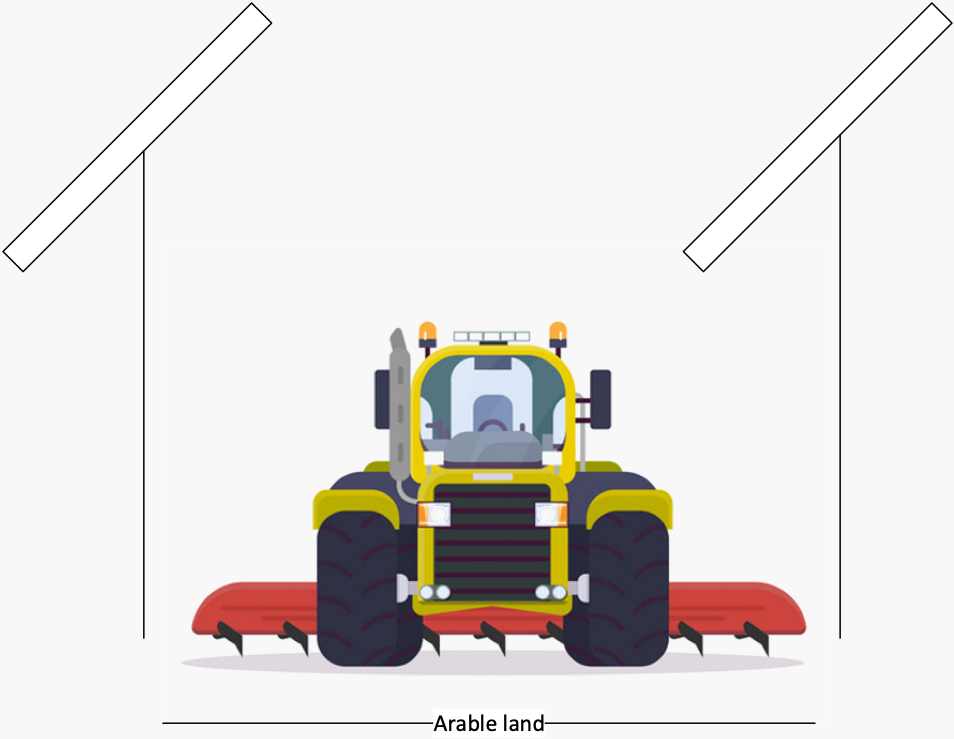
In this design you have to maintain a certain clearance between rows to protect the stilts from the machinery, so there is a modest arable land surface loss … usually 3-10%10. Many variations on this theme are currently under active research. Instead of fixed panel mounting, panels can be mounted with actuators11, allowing the panels to tilt in one or two directions, which allows for both solar energy and plant growth optimization. This can be particularly important during the initial stages of growth for some crops12.
But what about growing crops … UNDER … the elevated panels?
You’d think that solar panels casting shade on plants would be a bad thing, but the way photosynthesis works makes things interesting. Plants grow their mass out of CO2 with the help of sunlight. They literally are growing from the air … BUT … not all available sunlight can be converted into biomass. After a certain threshold, which is called the light saturation point, plants can’t absorb any more energy, so they need to get rid of that excess energy by evaporating water.
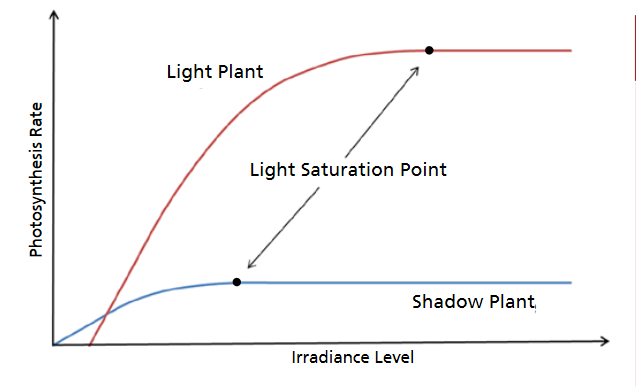
If we oversimplify this, we can divide the plants into two groups: “I’ll have my light supersized” plants and “can I order my light off the kids menu” plants. That group, the so-called shade plants, are particularly useful in combination with solar panels, since the panels obviously block some of the available sunlight13.
Now sun plants are sometimes referred to as shade-intolerant plants, which makes them sound like jerks. This is a slight misnomer, since these plants just require more sunlight than shade plants but can also suffer from too much sunlight14. When any plant reaches their threshold, they can suffer from ‘sunburn’ and heat stress, just like me, causing increased amounts of water evaporation … just like me.
According to a report from the German Fraunhofer Institute for Solar Energy15, nearly all crops can be cultivated under solar panels, but there may be some yield loss during the less sunny seasons for sun hungry plants. In the RESOLA project conducted between 2016 and 2018 in the German area of Lake Constance or the Bodensee as the Germans call it, they demonstrated that during a relatively ‘wet and cold’ year in 2016 APV-crop yields were 25% less than the non-solar reference field, but in the ‘dry and hot’ years of 2017 and 2018 the APV-crops yields exceeded the reference field. That’s a sign that APV could be a game changer in hot and arid regions.
The amount of experience with agrivoltaics is still fairly limited and the big successes have been mainly with shade tolerant crops like lettuce, spinach, potatoes, and tomatoes.
Which leads us to some of the super promising examples that make a compelling case for agrivoltaics.
Let’s switch over to The Netherlands. Tiny as it is, it is the second largest exporter of food in the world!
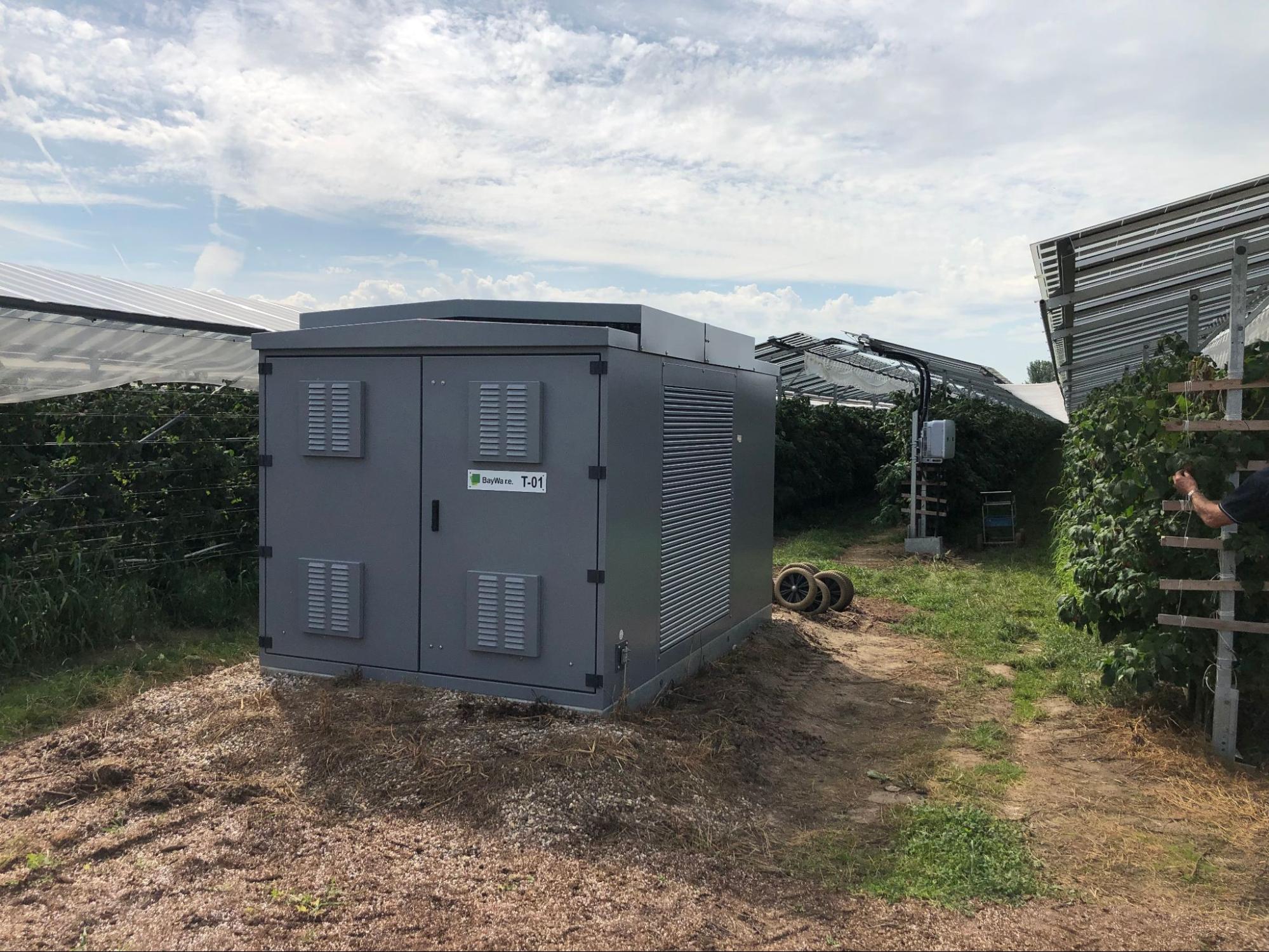
The company “GroenLeven”, a subsidiary of the BayWa group16, which is headquartered in Munich Germany, has started several pilot projects with local fruit farmers17. Their largest site is in the village of Babberich in the east of the Netherlands, close to the German border, at a large 4 hectare raspberry farm, which is about 10 acres for those of us not on metric. They’ve converted 3 hectares into a 2 MW agrivoltaics farm. The remaining part was left in a traditional farming setup. Raspberries are a fragile, shade tolerant fruit that’s typically grown in rows covered with plastic to help protect them from the elements and ensure high yields.
In this project the raspberry plants are grown directly under the solar panels, which have been placed in alternating rows facing east and west. This maximizes solar yield, but also protects the plants from the prevailing winds. They did test traditional solar panels in this project, but they took away too much of the available sunlight, so they switched to panels with a larger spacing between the solar cells to let more light through. The amount and quality of the fruit produced under the panels was the same or better as the fruit produced under the traditional plastic tunnels.
One big benefit for the farmer was the amount of work saved from managing the plastic tunnels, which are easily damaged by hail and summer storms18. In those cases fruits may become unsellable from the damage, but they still have to be harvested anyway. During the last summer storms, the fruits under the panels didn’t sustain any damage, while the harvest from the reference field was destroyed.
Another major difference between the argrivolatic test field and reference field: the temperature was several degrees cooler under the solar panels. Not only is it more pleasant for the farm workers, but it also reduced the amount of irrigation water by 50% compared to the reference field19. Even cooler is how the crops affect the solar panels. The crops and their limited water evaporation actually keep the panels cool. Solar panels actually don’t like to be hot, since it reduces their energy efficiency; the cooler a panel can be, the more energy it will provide.
So just based on that, agrivoltaics appears to be a winning strategy. If we were to convert even a fraction of our current agricultural land use into agrivoltaics, a large portion of our energy needs can be met … easily. And with the added benefits in reduced water consumption, agrivoltaics can also be a game changer in hot and arid regions of the world.
So what’s keeping us from rolling out this dual-purpose, game-changing system at a massive scale? What’s the catch? Energy production is a different ball game from agriculture, which can slow down farmers from embracing the technology. But the actual obstacles are sadly … mundane … and some frustrating.
It boils down to the the not-in-my-backyard effect (NIMBY), bureaucracy, and the free market.
So let’s start with the NIMBY crowd. Not all renewable energy solutions are receiving a warm reception. Prime example is obviously the sight and sounds of a giant wind turbine in the vicinity of your home. Community pushback from the residents of Reno County in Kansas killed a proposed NextEra Energy Inc. wind farm.20 Also in agriculture, there are examples where current laws enabled building giant biogas plants that weren’t always welcomed by the local communities. No matter the reason behind the community outrage and pushback, it’s this type of reaction that has killed or delayed many projects, as well as made many local governments gun-shy on pushing them forward.
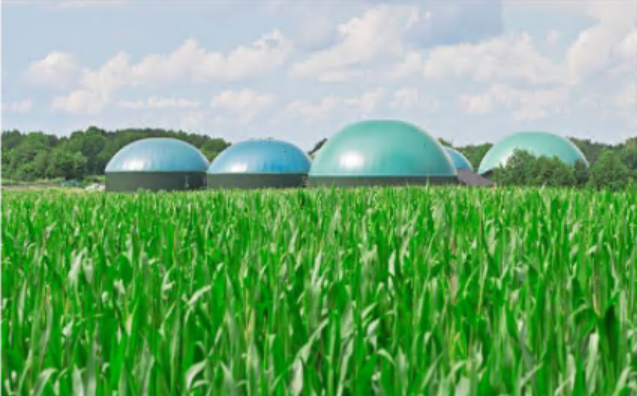
So in order to prevent communities turning against agrivoltaics it’s important to control its spread, especially pseudo-agrivoltaics (a practice to build large solar farms under the guise of agriculture). In protecting the people’s interest it helps to build community support, which is essential.
The Fraunhofer institute 21 recommends that
- Agrivoltaics should be deployed mainly where synergistic effects can be achieved, for instance by reducing the water demand for crop production.
And…
- To maintain proper local support, agrivoltaic systems should preferably be operated by local farms, energy cooperatives or regional investors.
With these guidelines in mind, community resistance against agrivoltaics can be kept to a minimum.
Next, rules, regulations, and bureaucracy can also hold it back, which varies from country to country or even from city to city.
“As part of its agricultural policy, the EU grants direct payments for land used primarily for agriculture. So, an important question is whether farmland loses its eligibility for financial support due to the use of agrivoltaics [….] … Whether the land is mostly used for agricultural purposes is decisive here”.22
In the EU, agrivoltaic systems are usually considered to be physical structures in terms of the building regulation laws, so they need a building permit. In Germany for instance, it’s usually prohibited in rural areas unless it doesn’t conflict with a list of public interests. Agrivoltaics, however, isn’t on the list of public interests yet23.
Lastly and maybe most important is the free market, which is pretty easy to wrap your head around because it all comes down to costs and investment. Just like putting solar on your home, the big number to look at is cost per kWh. Because agrivoltaic solar doesn’t yield as much energy per square meter compared to a traditional solar park, on top of the construction costs, the cost per kWh can be 10-20% higher24.
And there’s the big question of who owns the solar panels. In the Dutch example, the farmer wasn’t the investor or owner of the installation. A farmer’s willingness to participate all comes down to avoiding negative impacts to the crop yield and having lower operational costs from the solar panels. In this case the solar array owner was able to demonstrate those benefits.
The Fraunhofer institute found that farmers are only willing to engage in a project if the crop yield never falls below 80% of the reference field25, but … that’s only if the farmer owns the solar array. That’s because the farmer can make up the crop shortfall from the energy produced. But that also raises the question, if they own the array, how are they going to optimize the solar panels … for solar energy production or for crop yield? For the highest energy production per square meter, solar parks win out. For the highest guaranteed crop production, dedicated farming wins out. It all comes down to costs and investments. Without government intervention through subsidies or price guarantees, agrivoltaics may not stand a chance against other solar initiatives.
Agrivoltaics is a very promising concept that has the potential to kill two birds with one stone: helping our food supply and transitioning us to a cleaner energy source. The main benefit comes from the fact that solar panels are great at reducing GHG emissions, without sacrificing arable land. Especially if we can convert land that’s currently being used to grow biofuel crops, like palm oil and corn farms, into land for actual human food production and consumption … or even reforestation, that would be a huge win! Looking at the big picture and deciding where we want to go can help us find ways to overcome the difficulties along the way.
- WorldOMeter. (2021). Current world population. Retrieved July 13, 2021, from Worldometer ↩︎
- Gleick,P.H et al. (2014). _The World’s Water: The Biennial Report on Freshwater Resources. _Washington, DC: Island Press) ↩︎
- Frei, C., Whitney, R., Schiffer, H. W., Rose, K., Rieser, D. A., Al-Qahtani, A., … & Volkart, K. (2013). World energy scenarios: Composing energy futures to 2050 (No. INIS-FR–14-0059). Conseil Francais de l’energie. PDF ↩︎
- Trommsdorff, M., Gruber, S., Keinath, T., Hopf, M., Hermann, C., & Schönberger, F. (2020). AGRIVOLTAICS: OPPORTUNITIES FOR AGRICULTURE AND THE ENERGY TRANSITION. Retrieved July 11, 2021 from PDF ↩︎
- Scurlock, J. (2013). Agricultural Good Practice Guidance for Solar Farms. Building Research Establishment (BRE). Retrieved July 17, 2021 from PDF ↩︎
- ibid ↩︎
- PV Magazine – “Agrivoltaic project with vertically mounted bifacial panels goes online in Germany” ↩︎
- Khan, M. & Hanna, Amir & Sun, Xingshu & Alam, Muhammad. (2017). Vertical Bifacial Solar Farms: Physics, Design, and Global Optimization. Applied Energy. 206. 10.1016/j.apenergy.2017.08.042. http://www.researchgate.net/publication/316538778_Vertical_Bifacial_Solar_Farms_Physics_Design_and_Global_Optimization ↩︎
- Younas, R., Imran, H., Riaz, M. H., & Butt, N. Z. (2019). Agrivoltaic farm design: Vertical bifacial vs. tilted monofacial photovoltaic panels. ArXiv Preprint ArXiv:1910.01076. ↩︎
- Trommsdorff, M., Kang, J., Reise, C., Schindele, S., Bopp, G., Ehmann, A., … Obergfell, T. (2021). Combining food and energy production: Design of an agrivoltaic system applied in arable and vegetable farming in Germany. Renewable and Sustainable Energy Reviews, 140, 110694. Retrieved from ↩︎
- Barbose, G., Darghouth, N., Elmallah, S., Forrester, S., Kristina SH, K., Millstein, D., … O’Shaughnessy, E. (2019). Tracking the Sun: Pricing and Design Trends for Distributed Photovoltaic Systems in the United States-2019 Edition. Retrieved July 17, 2021 from PDF ↩︎
- Agostini, A., Colauzzi, M., & Amaducci, S. (2021). Innovative agrivoltaic systems to produce sustainable energy: An economic and environmental assessment. Applied Energy, 281, 116102. ↩︎
- Trommsdorff, M., Gruber, S., Keinath, T., Hopf, M., Hermann, C., & Schönberger, F. (2020). AGRIVOLTAICS: OPPORTUNITIES FOR AGRICULTURE AND THE ENERGY TRANSITION. Retrieved July 11, 2021 from PDF ↩︎
- Taiz, L., Zeiger, E., Møller, I. M., & Murphy, A. (2015). Plant physiology and development. Sinauer Associates Incorporated. ↩︎
- ibid ↩︎
- BayWa.r.e. ↩︎
- GroenLeven ↩︎
- GroenLeven – Solar energy and soft fruit ↩︎
- From interview with Willem de Vries, Groenleven (BayWa r.e.) ↩︎
- Bloomberg Green – “NIMBYs Shoot Down Green Projects Next Door While Planet Burns” ↩︎
- Trommsdorff, M., Gruber, S., Keinath, T., Hopf, M., Hermann, C., & Schönberger, F. (2020). AGRIVOLTAICS: OPPORTUNITIES FOR AGRICULTURE AND THE ENERGY TRANSITION. Retrieved July 11, 2021 from PDF ↩︎
- ibid. specifically section 6.1.1 ↩︎
- ibid specifically section 6.1.2 ↩︎
- Agostini, A., Colauzzi, M., & Amaducci, S. (2021). Innovative agrivoltaic systems to produce sustainable energy: An economic and environmental assessment. Applied Energy, 281, 116102. ↩︎
- Trommsdorff, M., Kang, J., Reise, C., Schindele, S., Bopp, G., Ehmann, A., … Obergfell, T. (2021). Combining food and energy production: Design of an agrivoltaic system applied in arable and vegetable farming in Germany. Renewable and Sustainable Energy Reviews, 140, 110694. Retrieved from http://doi.org/http://doi.org/10.1016/j.rser.2020.110694 ↩︎








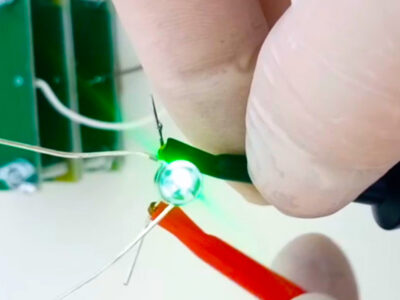






Comments